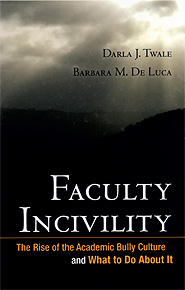The Rise of the Academic Bully Culture and What to Do About It

Darla J. Twale & Barbara M. De Luca. San Francisco, CA: Jossey-Bass, 2008; 219 pp; ISBN: 978-0-47019-766-0, cloth $40 USD.
Reviewed by Judy Haiven
In the Milgram experiments 50 years ago, “learners” and “teachers” were separated so that teachers could administer what they believed were electroshocks to learners who had answered questions incorrectly. Teachers in one room, learners in another, the physical separation allowed the former group to brutalize the latter. In today’s parlance, there was no “face time” between the two groups. Darla Twale and Barbara De Luca, the authors of Faculty Incivility: The Rise of the Academic Bully Culture and What to Do About It, have built on this theory to explain what takes place in the highest stakes game in the academy — the struggle for tenure and promotion.
The authors believe tenure and promotion procedures “remove the interaction from face-to-face interactions where actions are more likely to be fully observed.” (p. 76) In fact, a central plank of this very interesting book is that bullying and other forms of incivility in the academy are often hidden and regularly denied. (p. 51)
The book defines faculty incivility as “bullying, mobbing, camouflaged aggression, and harassment in the academic workplace.” (p. xii) Using examples from the literature and from interviews with current faculty members, the authors persuasively argue that the structure of universities, and how they are run, pave the way for uncivil behaviour among academics. Because the university administration is both “master and servant to the faculty,” (p. 69), there can be a duel for power and whichever wins tends to escalate bad behaviour. Individual faculty members who are judged to have less power fall victim to groupthink among their peers.
A look back in recent history shows that women and visible minorities hired in the 1970s and ‘80s experienced a “chilly climate” in part because they lacked “material well-being, power and prestige.” (p. 114) But Twale and De Luca insist the temperature has barely climbed because inequality, tokenism and marginalization act as a “precipitating factor” for incivility and a bully culture today.
Bullying may affect female faculty more than men. Indeed the book notes more women than men find bullying disturbing and debilitating, in the academic department, in the classroom and beyond. One anecdote an academic friend told me about concerned the “bad boy” and the “bad girl” in her department. Every time there was a contentious discussion in a departmental meeting, the “bad boy” used to swear and use expletives against the female members. Sometimes he stormed out. The “bad girl” played “gotcha” with the department chair, whom she bullied during meetings.
As faculty union president, I see the toll bullying takes on new faculty, or non-traditional or unusual academics unlucky enough to slip up in some way or other. I have seen that if a faculty member’s career is derailed by becoming a mother, or lagged due to anxiety or depression, or knocked by a less than stellar research or teaching portfolio, that person’s chance of getting tenure or promotion in a timely way evaporates. In fact, the slightest misstep is often exploited in the tenure and promotion process. This is a form of peer bullying the book examines in detail.
An interesting depiction of academic bullying is found in the Coen brothers’ 2009 film, “A Serious Man.” The main character, Larry Gopnik, a university professor, is up for tenure when his department chair announces he has received anonymous letters urging that Larry’s tenure be denied. The bullying comes not only from other academics but also from a student and the student’s father. In order to maintain his scholarship, the student begs Larry for a good grade. Though Larry refuses, he finds an envelope crammed with cash left on his desk. A clear bribe, Larry tries to return the money to the student, and the father goes to Larry’s house to bully and threaten him just that extra bit more.
Last year a similar thing happened to me. One student, who contributed to class discussions but rarely did the reading and scored poorly on essays and the exam, brought his father to see me. Both the father and son towered over me demanding I justify the grade and then boost it. The father became increasingly demanding and belligerent. Scared, I jumped up from behind my desk and waited outside my office until they left — without the better grade.
In just over 200 pages, authors Twale and De Luca examine the nasty underbelly of academic culture in American universities and hold it up to the mirror of corporate culture in the U.S. today. The book asks if it is “mission” or “market” which drives today’s universities? (p. 132) And is cultural capital built by universities being replaced by a “corporate push for quality and excellence?” (p. 130)
The last chapters of the book, though dedicated to what individual academics can do about the bullying, misses one important solution. There is no mention about the role of faculty unions or associations. What to us in Canadian universities could be a first line of defense against bullying, is nowhere in the U.S. context. Another point is that the incivility discussed in the book is often peer-on-peer harassment. This problem in no way justifies “codes of conduct” that some university administrations try to impose on faculty. These codes are little more than veiled threats to free speech and academic freedom.
---------------------------------------------------------------
Judy Haiven is a management professor and president of the faculty union at Saint Mary’s University in Halifax.